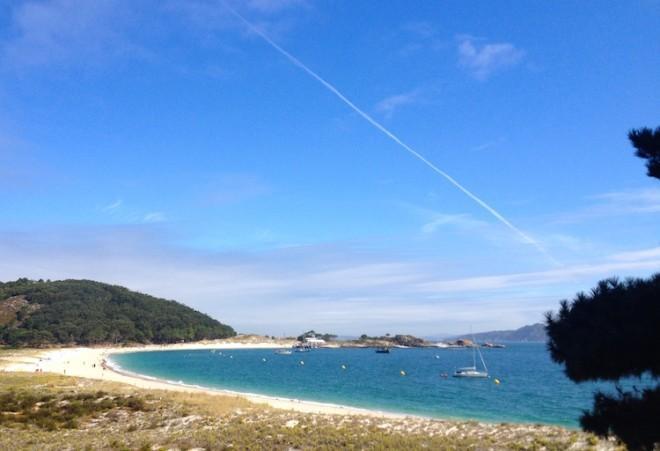In the northwest region of Galicia, a land of Celtic heritage and incredible seafood, await the Islas Cíes, or Cíes Islands, a stunning archipelago only reachable by boat and home to one of the biggest seagull colonies in Europe. Composed of crystalline waters and white sand, in 2007 The Guardian deemed Rodas Beach – which connects Cíes’ two largest islands – the best beach in the world.
What’s behind Cíes Islands’ national – and increasingly international – recognition? We explore that question and provide some answers below:
They are visually stunning
Three islands, none larger than 3km in length (about the width of Manhattan at its widest), and a few small islets overlook the bay of Vigo and the Atlantic Ocean, with deep cliffs, stunning sunsets and incomparable beaches. The longest beach, Playa de Rodas, connects the two biggest islands – Faro and Monteagudo – via a sandy isthmus.

Their sand beaches are to die forOn the eastern side of the islands you can find two stunning sand beaches: Figueras and Rodas, with very clear – and very cold – water, white sand, and all the warmth of the sun. Besides those two, there are seven other sand beaches all over the islands and islets, even a nudist one. The longest beach, Rodas, has a length of 1,200 meters, or around three quarters of a mile, making it prime beach walking territory.

Added benefit: it almost never rains here.
They feature generous hiking routes

The Cíes Islands have four different hiking routes. Three of them take visitors to a lighthouse – yes, that’s right, there are three beautiful lighthouses in Cíes – and the other leads travelers to a sensational spot for sunset watching, Alto do Príncipe. Better yet, these one to two mile-long hiking trails offer several bird observatories along the way, which are perfect for getting to know the islands’ avian denizens.
They’re perfect for naturalists

For most of the year, the islands’ only inhabitants are animals and the three park rangers who guard the place. Among these residents, birds are undoubtedly the islands’ kings. Seagulls and cormorants can be seen everywhere flying over the islands and fishing on the waters; it is the perfect rest spot for migrating flocks.
Under the sea, more than 200 types of seaweed populate this national park. After all, 85 percent of the park is marine, with mussels, barnacles, crabs, eels, octopus, clams, and scallops, just to name a few, calling this underwater habitat their home. On the surface, pines and eucalyptus populate the highest parts of the islands, and the toxo – a type of regional gorse – covers the lowlands.
A former refuge for pirates, the park can only be visited during the summer, and just 2,200 people are allowed on the island per day, most of them leaving on the evening boats. Since there are no trashcans, all visitors must pocket their trash and take it back to the mainland when they leave.
And camping…
On Easter weekend and from June to September, the camping sites open their doors to guests. Visitors can bring their own tents or rent one offered by the island management, which comes with army-style cots. Only 800 people can camp each night, making the experience unique and the space never crowded.
…and kids…
It is very common to see toddlers and older children camping with their parents. The island has clean, hot water showers, bathroom facilities, and even laundry stations for hand-washing clothes. It is forbidden to have parties around the tents or to play music at night, meaning that the camping experience is pleasant for everybody. The islands also have two restaurants, some bars and a small grocery store, so the camping-averse don’t have to spend too much time living “without.”
…and budgets

Two boat companies currently make the trip to Cíes Islands from three different locations on the Spanish coast. The fare is the same regardless of which company you choose: 16 euros on Easter and the weekends of June and September, and 18.50 euros for July and August.
Once on the island, camping means parting ways with 8.50 euros for a tent, 8.50 euros per adult and 6.20 euros per child, during the high season. Translation: for a family of two adults and two children, an overnight stay in paradise can happen for a little more than 80 dollars.
So, what are you waiting for? There is no excuse not to book your flight to Spain and fall in love with the wonders of the Cíes Islands.

